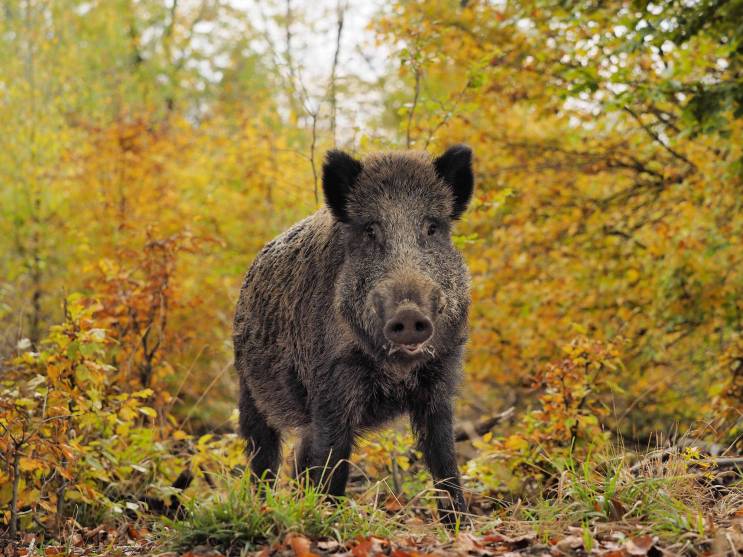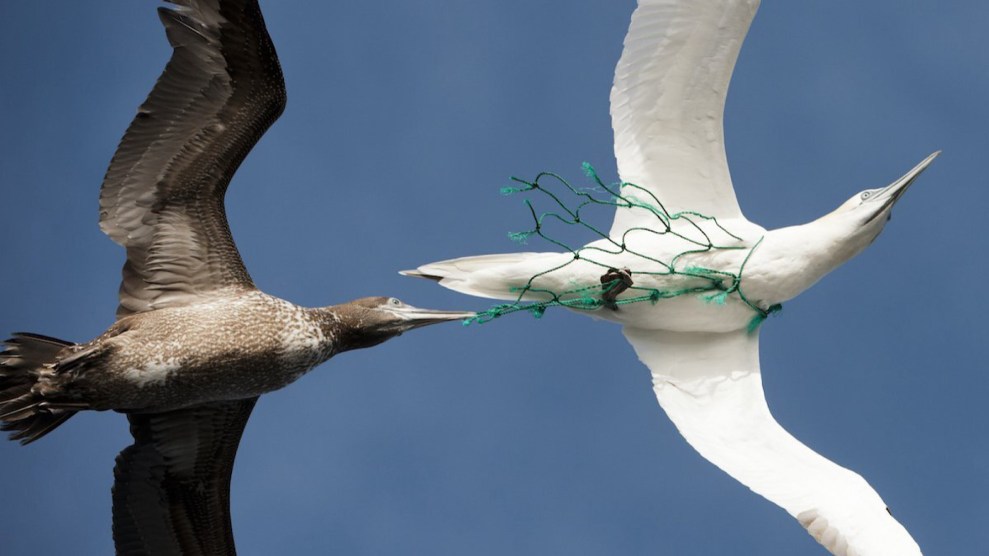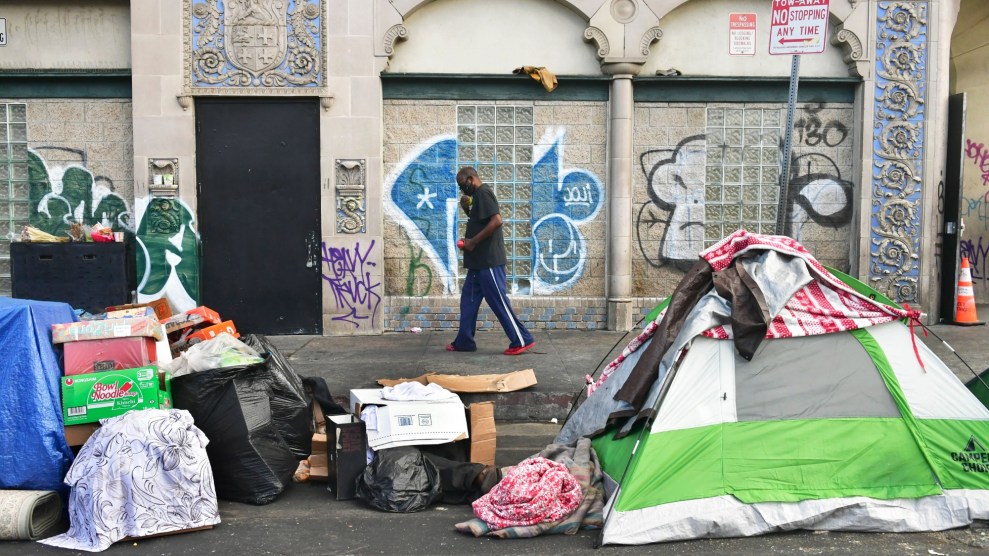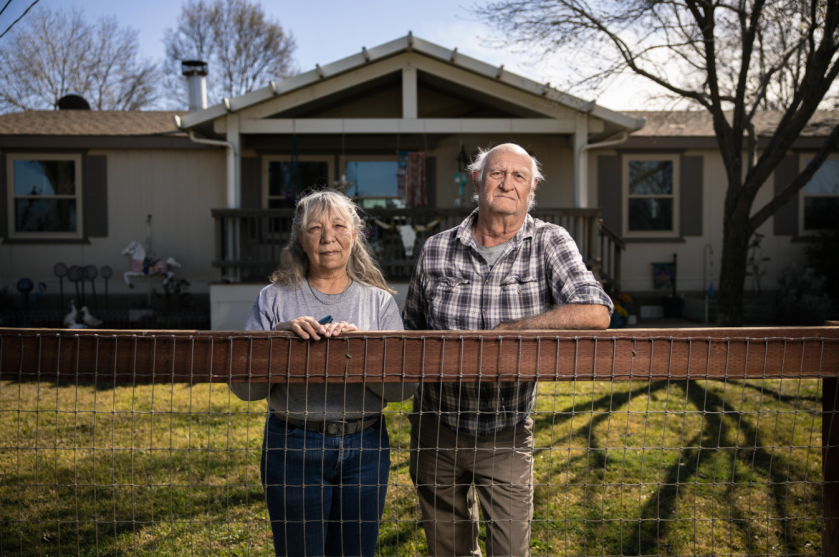
Wild Pig roaming in the Woods. November 4, 2015.ZUMA
This story was originally published by Undark and is reproduced here as part of the Climate Desk collaboration.
Early one winter morning in 2020, Kurt VerCauteren discovered a cluster of dead birds in a barren field in northwest Texas. They were small birds, mostly dark-eyed juncos, but also a smattering of white-crowned sparrows.
VerCauteren’s team had poisoned them, inadvertently. The clues were clear, the death uncomplicated: The birds had flown in before dawn to scavenge deadly morsels of a contaminated peanut paste, left behind after a sounder of wild hogs had torn through the area in a feeding frenzy. The birds likely died within minutes of eating.
“I couldn’t even see the crumbs,” says VerCauteren, a wildlife biologist at the US Department of Agriculture in Fort Collins, Colorado, who has spent years developing and testing pig poisons. The birds were the unintended victims of a field experiment to test a toxicant—one intended for feral pigs, but no other animals—that had been developed in Australia. In the days before, VerCauteren and his collaborators had assembled heavy, sophisticated feeders and filled them with the mash laced with a heavy dose of sodium nitrite, a salt often used in processed meats. When the pigs ate, they’d left tainted crumbs behind—not many, but enough.
There are currently no poisons that can be legally used in the United States against wild hogs, but not for a lack of options. For nearly a century, scientists have investigated chemicals that can fell big, vertebrate pests—particularly feral swine. The animals have become a growing scourge across the country, with as many as 6 million of them causing enormous damage to crops, livestock, and native habitats from North Carolina to California and Texas to Florida. “When you have a grossly overabundant species, the kind of damage they can do is huge,” VerCauteren says. “Sometimes you have to remove the animals to solve the problem.”
Wild hogs pillage cornfields, forests, and cemeteries, leaving behind messes that look like the work of angry asteroids. Between destruction and control costs, the animals cost the country at least $1.5 billion annually, according to the USDA, though ongoing research indicates the actual figure is considerably higher. Analyses of their stomach contents and feces show that they eat almost anything, including tree stumps, small vertebrates, sea turtle eggs, amphibians, baby goats, turkey eggs and turkey hens, and young deer—“anything containing carbon,” says VerCauteren.
But feral hogs don’t wreak havoc in a vacuum. What they eat, other animals like raccoons and bears also eat; and when they die, other scavengers may eat them. Poisoning is a vastly complicated undertaking that not only requires knowledge of what the animals eat, but also when they eat, and where they go, and what other animals are around. It’s a quest that scientists like VerCauteren won’t solve with biology and chemistry alone, but also with engineering and technology informed by game theory and risk calculation.
How do you find something that will kill a hog, and only a hog?
“You want it to be effective, you want it to be humane, and you want it to only kill what you want to kill,” says VerCauteren. But pigs “are smart, they’re risk averse, and they don’t want to die. If there’s a signal that it could be dangerous, they’ll pick up on it.”
States have developed a spectrum of strategies to control the menace. Many allow hog hunting, but “recreational sport hunting only takes about a quarter of the wild hog population every year,” says Jack Mayer, a researcher at the Savannah River National Laboratory in South Carolina. In addition, hunting seasons can worsen the problem when landowners truck swine to their properties to encourage paying hunters. And, of course, the hogs can escape. On top of that, they’re smart: The animals have been observed changing their daily foraging patterns to avoid human hunters.
Another option is trapping: State-of-the-art traps use remote control gates and tree-mounted cameras equipped with motion sensors. But trapping isn’t foolproof and doesn’t effectively control hog populations in large regions. It also doesn’t fool all the pigs all the time. Trapped hogs have been known to pile on each other’s backs to scale fences 5 or 6 feet tall, says VerCauteren. They can run 30 miles per hour and jump 3 feet in the air, and can also learn to avoid traps altogether.
Poison sounds like an appealing addition to the arsenal of solutions. There have been many candidates over the years. Sodium fluoroacetate, an odorless salt used in New Zealand and a handful of other countries to control pests, has no antidote and kills an animal by interrupting its metabolism. But scavengers that eat poisoned carcasses may die, too. The United States banned widespread use of the salt in 1972 after people raised concerns about its humaneness and the high probability of accidental poisoning.
Other options include yellow phosphorus, but the amount that would be required to kill a 200-pound hog makes it untenable. In August 2019, the Trump administration reauthorized the use of cyanide bombs—small contraptions that release clouds of deadly poison when triggered by an animal—but a week later, the Environmental Protection Agency acknowledged that of the more than 20,000 public comments it received, nearly all opposed the bombs and withdrew its support. The following December, the agency re-reauthorized limited use of the deadly tool for controlling coyotes, red fox, gray fox, and wild dogs believed to threaten livestock or human health, but the poison is not permitted against feral hogs.
At the moment, there are two main toxicants under intense study in the US, and the USDA has made getting a product on the market a priority. One is warfarin, a blood thinner that was one of the first registered rodenticides in the U.S and is still found in rat traps today. A warfarin-based product was briefly approved under an emergency order for use against feral hogs in Texas before a judge blocked it and the manufacturer rescinded its application. The other is sodium nitrite, the heavy salt used in the Texas trials last year. Warfarin has had a controversial run in this country, while sodium nitrite looks a little more promising—if biologists can figure out how to package it. The pigs, meanwhile, continue to run rampant.
About 30 million people in the US take a few milligrams of warfarin daily to prevent blood clots. Since 1948, it’s also been sold as a pesticide. Once rodents like rats and mice ingest even a small amount, warfarin causes fatal internal hemorrhaging. It’s the active ingredient in many rodent bait stations.
Fourteen years ago, biologist Richard Poché saw the potential of using high doses of warfarin to control pig populations. At the time, Poché ran Genesis Laboratories, a Wellington, Colorado company that focuses on wildlife that carry and spread diseases, which is now owned and operated by his son, David. Rodent baits typically contain a warfarin concentration of about 250 parts per million. Poché says that lower fractions—even one-fifth the ratio used in rodenticides—would be lethal for hogs. “We cut the dosage and still had excellent control of hogs,” he says.
In 2014, the EPA issued Poché a permit for Genesis to test warfarin in Texas, authorizing the first field test of a hog-targeted toxicant. Poché’s group used a warfarin bait called Kaput, manufactured by a company called Scimetrics, which is owned by Poché and at the time was run by his wife, Linda.
Richard Poché’s group added a fat-soluble tracer to the poisoned food that colored the dead animal’s innards bright blue to alert hunters that the hog had ingested the poison (and to avoid eating the meat). Over an eight-week period, Poché reported, warfarin bait killed about three-dozen hogs and no other animals. He also noted that when the researchers searched the area, they found no carcasses of other animals that had been inadvertently poisoned. The EPA authorized its use, and in February 2017 Texas became the first state to allow commercial use of warfarin against feral hogs.
“The ‘feral hog apocalypse’ may be within Texans’ reach,” Sid Miller, the state’s agricultural commissioner, declared at a press conference at that time.
Hunting groups and companies that process boar meat quickly filed a complaint against the state, pointing out that Australia had phased out use of warfarin because it was such a cruel killer. “Hogs die by bleeding to death—including bleeding out the eyes, nose, mouth, and other body orifices,” the complaint read. “The death is painful and gruesome.”
One of the complainants was the Wild Boar Meat Company in Hubbard, Texas. The company processes wild hog meat for pet food, and it pays hunters for every carcass—alive or recently killed—that they bring to the shop. Its owner, Will Herring, estimates that since it opened, the company has processed 800,000 carcasses.
Herring says he is not opposed to poison, but maintains that Scimetrics, Kaput’s manufacturer, didn’t provide enough information to ensure the product was safe for other animals or the environment. “There were quite a few details not disclosed,” he says, “like how effective it was, or how much it costs.” It wasn’t clear, he says, how the product would affect the food chain.
In March 2017, just a month after the state gave warfarin the green light, a judge blocked its approval. In April, Scimetrics decided to withdraw its application to register the product in Texas. Poché says he felt blindsided. “We didn’t anticipate that these hunter groups felt we would be cutting into their livelihood, but there are enough feral hogs to go around for everybody,” he says. “Kaput was pulled so everyone could regroup and see what was going on.”
Since then, James Beasley, a wildlife ecologist at the University of Georgia, has been leading one of a handful of ongoing efforts to study warfarin. “People felt they needed some additional clarification,” he says. “All the published literature was based on studies from the manufacturer. Naturally, that begs for more research from independent researchers to try and validate those findings.”
Beasley’s group has run pen tests—experiments in which the hogs’ only choice of food was poisoned bait—showing that warfarin effectively kills the animals. It also appears to be humane, as Beasley says he rarely observed more upsetting effects like external bleeding and didn’t see the vocalizations reported in trials in Australia, though many of the pigs exhibited vomiting shortly before death. But when he tested the bait in the wild, Beasley found that the pigs kept their distance. “We quickly realized that hogs were coming but not interested in the bait,” he says.
Meanwhile, Poché continues to test warfarin. He’s confident that as the hog problem worsens, warfarin will look more appealing. “Once it reaches a crisis level, which we’re fast approaching, things will be really stressful for farmers,” he says. “Then they’ll say, let’s do something about the pigs.”
The leading alternative to warfarin is sodium nitrite, the compound that killed a cluster of small birds in the northwest Texas trial last year. In its crystalline form, sodium nitrite looks like a yellower cousin of table salt. It occurs naturally in arugula, beets, and other vegetables; in concentrated doses, it’s used to cure sausage and bacon.
When a hog eats sodium nitrite, the salt triggers a condition called methemoglobinemia, which means red blood cells stop delivering oxygen to tissues. Inside the body, the blood darkens. The animal stumbles. “They suffocate from the inside,” says VerCauteren. “They get lethargic and lay down and go to sleep. It puts them in a coma and they don’t wake up.”
He likens it to death by carbon monoxide poisoning. Compared to other poisons, he says, sodium nitrite is more humane. That word — humane — invokes another obstacle that a pig poison has to clear. “Humaneness has got a different meaning to everybody,” says Beasley. “You and myself and five other people in the room would define it differently.”
Ngaio Beausoleil, an animal welfare researcher at Massey University in Palmerston North, New Zealand who studies the intersection of people and wildlife, says humane is a relative term. She and her colleagues define a humane method of killing an animal as one that causes the least “welfare harm.” But that definition invokes a number of further questions: “What is the kind of harm, what is it like for the animal to experience that, how intense is that experience, and how long does it last?” Compared to other poisons, she says, sodium nitrite does seem more humane.
VerCauteren began investigating sodium nitrite eight years ago using an Australian product called Hoggone. In 2013, his group launched their first pen test in Texas. The scientists mixed Hoggone with corn bait and took a bucket to Justin Foster, a biologist who coordinates wildlife toxicology research projects for the state of Texas.
“We always have him give the sniff test,” says VerCauteren. “He has a sensitive nose.” Foster recoiled: The odor was overwhelming. “If he can detect it, the hogs can detect it, and they’re not going to eat it,” VerCauteren says.
Through laboratory and pen trials over the next few years, supported by the USDA’s National Feral Swine Damage Management Program, the researchers refined their approaches. They began with chemistry, disguising the intense salty odor and flavor by encapsulating crystals of sodium nitrite to create tiny capsules that dissolve inside a hog’s stomach. “Imagine a grain of salt with a candy coating,” VerCauteren says.
Then came biology, with a dash of food science: They couldn’t pack the poison in anything water-based because water would dissolve the capsule and release the salt. They also needed something that would stick together, so they came up with a recipe that mixed tiny capsules of the poison in peanut paste. “If I give my kid a graham cracker, there’s crumbs everywhere. If I give ‘em a marshmallow, there’s no crumbs,” says VerCauteren.
Then came engineering the feed boxes. In order to keep off-target animals out, including stronger ones like bears, the scientist modified their feed box using artificial intelligence. Whenever a hog roots around the box and makes hog-noises, a microphone picks up the sound and sends it to a computer program that can analyze a video image and determine if it’s really a hog. If it’s not—if it’s a bear, for example—then the door remains locked. If it is a hog, the door unlocks, and the hog is free to lift and eat, and die. Because the AI-enabled boxes are expensive, VerCauteren says, they will only be used in areas shared by pigs and bears.
The bear-proof box design was finished in early 2016, according to VerCauteren, but the researchers are still refining the acoustic and visual system to unlock the smart feeder. In pen tests, the smart feeder killed just as many hogs as earlier setups using sodium nitrite, which suggested that the right animals were getting in. “We were feeling pretty good with all these changes,” VerCauteren says.
In recent years, the group has launched field studies at two sites, both heavy with hogs: one in the hot, damp forests of Alabama, and the other in the hot, dry plains of west Texas. In Alabama, the bait box successfully blocked raccoons, possum, and other small vertebrates. Only the hogs ate the sodium nitrite and died.
But during the Texas tests in 2018, the scientists discovered more than 170 dead birds and eight dead raccoons. “We were killing those birds,” says VerCauteren.
Clearly, there was a spillage problem. The researchers continued to tweak the bait—reducing the concentration, thickening the paste—until the winter of 2019-2020, when they ran another field test in Texas. By this time, VerCauteren says, they’d reduced the total spillage to a fraction of what it had been before. They were confident, totally convinced, that no animals could get in. There were no crumbs in sight.
But again, they found dead birds.
Because of the Covid-19 pandemic, VerCauteren has been hunkered down in Fort Collins—but he’s been busy trying to solve the bird mystery. His wife, Tammy, runs the Bird Conservancy of the Rockies, so he’s suddenly interested in everything she knows. “I am quizzing her constantly, and her biologists,” he says, “to make sure I’m not screwing this up.”
In the spring of 2020, VerCauteren tested four bird-repellant strategies near his government lab in Colorado. One uses a grate installed beneath the feeder box to catch the crumbs after the hogs eat. Previous studies showed that most of the poisoned birds died within 18 inches of the feeder, so that’s the size of the grate.
The second tested the effects of spraying methyl anthranilate around the bait box. Methyl anthranilate is a nontoxic compound responsible for the grape flavor found in grape-flavored bubble gum and candy and soda; it’s also a proven bird repellant. VerCauteren hoped the change would not only drive birds away, but also attract hogs with the sweet smell.
The third experiment used an inflatable scarecrow called the Scary Man. “It’s a human-sized balloon effigy,” VerCauteren says. Every morning, he donned a headlamp and trudged out to the field an hour before sunrise to flip the switch that brings the Scary Man to life. “This guy pops up out of nowhere, then scare, scare, scare, then deflates,” he says. The Scary Man should save the birds’ lives by shooing them away, “but that didn’t work very well,” said VerCauteren.
The fourth experiment tested what was essentially an inflatable snake that danced above the bait box, called a Scare Dancer. With a 96 percent reduction in bird visitation, the Scare Dancer emerged victorious. In June, VerCauteren ran another field trial in Texas, combining the bait boxes with the inflatable snakes, and didn’t find a single dead bird. After reviewing the data, the EPA gave VerCauteren the green light to launch two larger field tests this summer, returning to Alabama and Texas. A commercially available sodium nitrite-based bait is likely at least three years away, he predicts.
Finding a hog poison that can clear all the hurdles, says Beasley, the University of Georgia researcher, would be a welcome weapon. “There’s no one approach that’s going to work in all situations,” he says. “Each individual hog, each local population, responds differently to different control measures.”
“A toxicant is not a silver bullet,” he adds. “It’s just another tool in the toolbox that people have to control pigs.”
Stephen Ornes is an award-winning science writer who lives in Nashville, Tennessee, and covers feral hog research as often as he can. His work has appeared in Discover, Quanta, Scientific American, and other outlets.
















